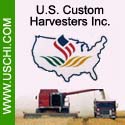 |
 |

|
|
|
Minnesota Ag News Headlines |
 |
Master Naturalists Go Into the Wild
Minnesota Ag Connection - 10/29/2020
Susan Binkley waded into the waters of the St. Croix River in search of a Wabash pigtoe--a freshwater mussel roughly 3 inches in diameter with a smooth yellow-brown outer shell. Like all bivalves, the Wabash pigtoe filters water through its gills, subsisting on algae and bacteria and leaving the water cleaner and clearer. More than 40 species of freshwater mussels thrive in the St. Croix, but they're vanishing quickly worldwide for reasons scientists don't fully understand.
When Binkley found what appeared to be a Wabash pigtoe, she handed it to University of Minnesota researcher Mark Hove for confirmation. Hove had recruited a dozen volunteers to help him with his field research. The group of citizen scientists included graduate students, high school kids, retirees, and several folks--including Binkley--who had been certified as Master Naturalists through University of Minnesota Extension.
Minnesota's Master Naturalist program was launched in 2005 with the goal of creating "a corps of well-informed citizens dedicated to conservation education and service" in Minnesota. Twenty-two students enrolled in the first session, held at Fort Snelling. Last year, more than 400 people participated in Master Naturalist classes in a dozen locations across the state--making the program among the most popular Extension offerings.
"We get a lot of people who say, 'This is what I wanted to do my whole life,'" says Amy Rager, the program's director.
Many participants have a science background, but lack specific training in biology, ecology, or other topics covered in the Master Naturalist curriculum. Roughly 30 percent of participants have doctorates, and many are familiar with lab practices and protocols. "They're curious and passionate about the outdoors, but they also bring skills to the table," Rager says.
Students undergo 40 hours of classroom training, learning about Minnesota's geology, climate, flora, fauna, and bugs. Participants also take field trips to nature areas and research labs. After completing their coursework, Master Naturalists are required to complete 40 hours of volunteer work a year such as banding birds, counting bees, removing invasive species, and collecting specimens for projects like Hove's mussel study.
The variety of people within the Master Naturalist group proved stimulating to Hove. "There were artists and nonscientists who made me think a little differently about my work," he says. "The people in the program are really excited about the natural world. And I am, too--so the enthusiasm was mutually contagious."
"Many Master Naturalists form a bond with their instructors and become passionate advocates for the research," Rager says. "It's a win-win for everyone."
Other Minnesota Headlines
|
|
 |


|
 |
|
Copyright © 2024 - Farms.com. All Rights Reserved. |
 |
|